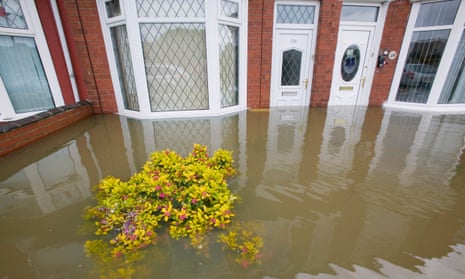The rush to build one million new homes in England by 2020 is set to increase flooding by overwhelming drains, according to the nation’s building and flooding professionals.
The risk could be avoided, however, if the government ends its seven-year freeze on implementing legal requirements for new developments to include sustainable drainage systems (SuDS), such as ponds, green roofs and permeable paving. These slow the flow of water into drains, cutting the risk of floods.
Flash flooding, where heavy rain overwhelms sewers, is already the most frequent type of flooding and costs about £260m a year. Flood risk is also expected to rise as climate change is leading to more intense rainstorms. But at present new housing developments can simply connect to existing drains, increasing the risk of floods.
A law requiring new developments to include SuDS was passed in 2010, but the government put the rules on hold, aiming to save developers money and speed up house-building. But a report published on Thursday by a coalition of professional institutions finds the policy freeze has not sped up house building and has put homes at risk of flooding, without saving money.
The report urges the government to use a current review to finally implement the rules. “We recognise the urgent need for 1m new homes but it is pointless to build in a way that creates flood risk for the future,” said Terry Fuller, chief executive of the Chartered Institution of Water and Environmental Management, one of the bodies that produced the report.
“Our analysis shows the main obstacles to high quality and widely implemented SuDS are political and institutional rather than technical or financial, so there is no reason why government should not support stronger policy,” he said.

SuDS can also provide valuable habitats for wildlife and Martin Spray, chief executive of the the Wildfowl and Wetlands Trust, said: “The government’s freeze on sustainable drainage policy is a loss for wildlife and a loss for communities. But we can make this change affordable and quick, delivering new defences and new habitats, without slowing down house-building.” Other bodies backing the report include the Royal Town Planning Institute, the Royal Institute of British Architects, the Institution of Civil Engineers, the Association of Drainage Authorities and the RSPB and WWF.
“People living with the threat of flooding are deeply worried about how new developments will increase their flood risk. It’s undoubtedly the biggest problem we hear about, along with insurance,” said Paul Cobbing, head of the National Flood Forum, which represents flood-prone communities across the country. “We run the risk of thousands suffering the devastating effects of flooding much more frequently. We need to take action to ensure we’re creating and building flood-resilient communities for today and for 30 years’ time.”
A spokesman for the Department for Communities and Local Government said: “We’ve put in place strong safeguards to stop inappropriate development in areas at risk of flooding, and we are clear that sustainable drainage systems are critical for reducing surface water flood risk. Planning authorities have to make sure new buildings are flood-resilient and we expect sustainable drainage systems for all new developments with 10 or more homes.”
Existing planning rules encourage the use of SuDS, but a survey of more than 500 industry professionals for the new report, including engineers, flood experts and planners, found only 8% believe that current standards are driving high quality and effective SuDS in England.
The government’s official advisers, the Committee on Climate Change (CCC), also found only one in seven planning applications in areas of flood risk in 2015 contained the phrase “sustainable drainage”.

The new report also found that many SuDS that were installed were poor quality. The government’s own research shows SuDS are often cheaper to build and maintain than traditional drainage systems and the CCC estimates that they save £2 for every £1 spent.
In 2016, the government rejected proposals to use its Housing and Planning Act to increase the use of SuDS. Lord John Krebs, then at the CCC, told the Guardian: “In 20 years time, people will look back and say, ‘What were they thinking?’”

Comments (…)
Sign in or create your Guardian account to join the discussion